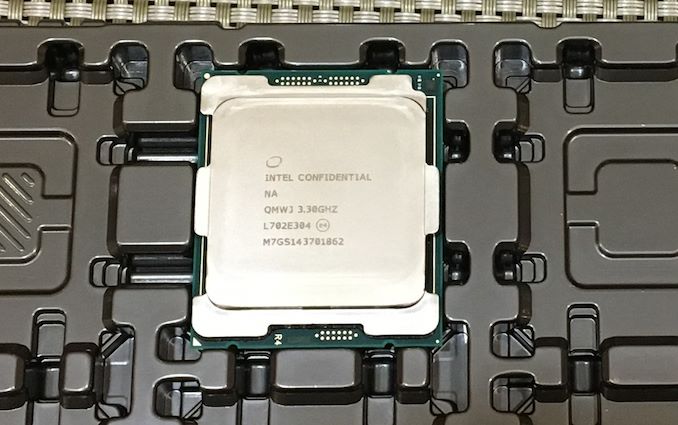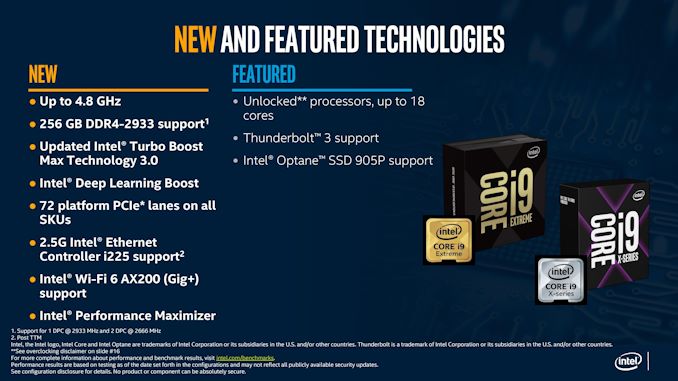Intel's Cascade Lake-X CPU for High-End Desktops: 18 cores for Under $1000
by Dr. Ian Cutress on October 1, 2019 6:35 PM EST- Posted in
- CPUs
- Intel
- HEDT
- LGA2066
- Cascade Lake

With someone in the press having broken their embargo earlier today, Intel is lifting the lid earlier than planned on their upcoming Cascade Lake-X family of processors for the high-end desktop (HEDT) market. Similar to the way Intel's Cascade Lake based Xeon Scalable processors are a further revision of their Skylake Xeons, offering clock speed increases and security fixes in hardware, the new HEDT processors will grant higher frequencies, more memory capacity, and better protection against side-channel attacks. The key numbers however are the big drop in Intel's pricing: Intel will be releasing its 18-core part, the Core i9-10980XE, for under $1000.
| Intel Cascade Lake-X | |||||||
| AnandTech | Cores Threads |
Base | All Core |
TB2 | TB3 | TDP | Price (1ku) |
| Core i9-10980XE | 18C / 36T | 3.0 | 3.8 | 4.6 | 4.8 | 165 W | $979 |
| Core i9-10940X | 14C / 28T | 3.3 | 4.1 | 4.6 | 4.8 | 165 W | $784 |
| Core i9-10920X | 12C / 24T | 3.5 | 4.3 | 4.6 | 4.8 | 165 W | $689 |
| Core i9-10900X | 10C / 20T | 3.7 | 4.3 | 4.5 | 4.7 | 165 W | $590 |
| Skylake-X (previous generation) | |||||||
| Core i9-9980XE | 18C / 36T | 3.0 | 4.5 | 4.7 | 165 W | $1979 | |
| Core i9-9940X | 14C / 28C | 3.3 | 4.5 | 165 W | $1387 | ||
| Core i9-9920X | 12C / 24T | 3.5 | 4.5 | 165 W | $1189 | ||
| Core i9-9900X | 10C / 20T | 3.5 | 4.5 | 165 W | $989 | ||
This pricing is a significant shift in Intel's strategy, and a number of fingers will be pointed at AMD as having made this happen. Next month AMD is set to launch its 16-core Ryzen 9 3950X at $749, which will offer 16 PCIe 4.0 lanes for slots (+4 for M.2, +4 for chipset) and support for 128 GB of DRAM. So Intel needed something similarly speedy, but with more PCIe lanes and more memory support that they could offer for just a bit more, leading to the 10980XE for $979. Ultimately, the on-shelf price is often just slightly higher than tray price, so don't be surprised if retail prices land at around $1000.
All the CPUs will support 256 GB of quad-channel memory (up from 128 GB), and have 48 PCIe 3.0 lanes (up from 44). Memory speed support is listed as DDR4-2933 for 1 DIMM per channel, and DDR4-2666 for 2 DIMMs per channel. All these CPUs have a TDP of 165 W, which Intel states will help the CPUs to turbo longer under Intel's recommended settings (as we know, consumer motherboard manufacturers like to ignore these anyway). All these CPUs are supported in X299 motherboards.
There is no 16-core in this stack, with Intel's official reasoning being that they assess the market with each generation and they don't believe there's a suitable price point for such a part when the 14C and 18C parts are so close. Most people will point the finger and say that no-16 core Intel part means no direct comparison with the Ryzen 9 3950X, which is something to think about.
Another point to note is that Intel has stopped this stack at the 10 core and no lower. This means that there will be no cross over between Intel's consumer processor stack and the HEDT stack, with users needing to spend just a little bit more from the Core i9-9900K/KF to reach up to the Core i9-10900X. It will be interesting to see where Intel's Core i9-9900KS fits in, although that still only has dual channel memory and 16 PCIe 3.0 lanes.
Intel lists Wi-Fi 6 and 2.5GbE support on these new processors - to clarify, Intel means external controllers here. For some odd reason when Intel says support, it could mean internal to the chipset or external via a controller; this is messaging I've railed against for a while, as it ends up confusing for enthusiasts, especially when this is an enthusiast platform. It does mean however that we get official information about Intel's 2.5GbE controllers, which we've been waiting on for a couple of years. Intel stated that these controllers will be ready at a later date, and more information to follow. (The controllers are currently listed on Intel's ARK database, but as 1 GbE controllers for some reason.)
These CPUs will have the same security mitigations as the Cascade Lake Xeon processors, with updated hardware mitigations for a number of side channel attacks. We are waiting to hear from Intel if the firmware that supports these processors will also have additional fixes in for Zombieload by default.
One question about this launch is surrounding Intel’s 14nm capacity. Within the last week, there have been reports that despite Intel’s best efforts and promises to match demand, and that Q3 and upcoming for Q4 is going to be busier than expected. We reached out to Intel last week for clarification, and the company said that the bulk of its capacity is focusing on the high-end processors in the market: the Xeon Scalable, the Core i9, Core i7, and Core i5. It will be interesting to see if launching another family of products is going to put additional strain on Intel’s capacity and demand.
With AMD's recent Zen 2 Ryzen 3000 series launch on 7nm earlier in the year, Threadripper 3 coming later this year, and Intel swinging another generation of 14++ into the high-end desktop market, Intel is going to have some tough times. Don't get me wrong, this pricing update from Intel is a good thing for users, especially those looking at implementing things like DL Boost to their workflow, but this market is suddenly turning very aggressive, and it will be interesting to see if Intel can be agile enough to keep pace.
Intel's Cascade Lake-X processors will be available in November. More details should be released nearer to launch.











162 Comments
View All Comments
Eliadbu - Tuesday, October 1, 2019 - link
Intel TDP rating is at base clock running complex workload. Many people people still don't get it apparently and are surprised when they see the TDP at boost clock. Sure it is less straightforward but it is not lying. About price affter we will see AMD HEDT offering we will judge16 pci-e always was the case for non HEDT desktop ryzen chips. You got
Eliadbu - Tuesday, October 1, 2019 - link
16 pci-e from CPU directly connected to GPU and 4 pci-e link connected to the X570 chipset which adds additional 8 platform PCI-E, you just fell for another trick of AMD marketing. I swear they getting worse than intel in that regard.Flunk - Tuesday, October 1, 2019 - link
The Zen 2 Ryzen CPUs (3000 series, but not APUs) have 24 PCI-E 4.0 links. 16 for the GPU, 4 for the chipset link and 4 that are most often used for NVMe drives. X570 has 16x PCI-E, you're thinking of the last-gen Ryzen CPUs.https://www.anandtech.com/show/14525/amd-zen-2-mic...
Hul8 - Tuesday, October 1, 2019 - link
All 24 lanes are usable as PCIe, if you omit the chipset. (Like the A300 "chipset" in some prebuilts.)Karmena - Wednesday, October 2, 2019 - link
Are you sure about "complex load"? What is that? Definitely not something that includes AVX.evernessince - Tuesday, October 1, 2019 - link
Intel rates their CPUs at base clock only so yeah, their TDP is extremely misleading.dysonlu - Tuesday, October 1, 2019 - link
LOL If history serves, "competition" may be short-lived as Intel will undercut (see "predatory pricing") its competitor and, soon enough, it will enjoy milking its customers again.From wikipedia on "predatory pricing": "Predatory pricing is considered anti-competitive in many jurisdictions and is illegal under some competition laws. However, it can be difficult to prove that prices dropped because of deliberate predatory pricing, rather than legitimate price competition. In any case, competitors may be driven out of the market before the case is ever heard."
azfacea - Wednesday, October 2, 2019 - link
what r u talking about? price per transistor has dropped 1 milion times in the last 50 years. have u heard of innovation?also intel did no such thing as drive amd out with predatory pricing. it used its volume and node advantage to drive out amd. it has no such advantage over TSMC
milkywayer - Wednesday, October 2, 2019 - link
Go away Troll.For kids who're reading this in the Future for research; Intel used all kind of scammy tactics including bribing Dell and the likes to keep stuffing Intel's CPUs at a major discount just so they could drop AMD CPUs.
Klimax - Wednesday, October 2, 2019 - link
You are conveniently ignoring plenty of idiocies on AMD side including starving itself of cash by purchase of ATI… (And betting on pure nonsense called Bulldozer)Also Intel had always massive margins thanks to vertical integration. (People forget that for some years during Pentium 4 era AMD was more expensive then Intel - Black Edition says hi)